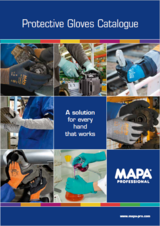Definition
A
- Ambidextrous
-
Ambidextrous gloves can be worn equally well on either hand; this is principally the case for thinner gloves.
- Anatomical
-
A glove is called anatomical when there is one shape for the left hand and another for the right.
B
- Butyl
-
Butyl offers excellent chemical resistance against ketones, acids, esters and amine derivatives. It is a supple and elastic synthetic material, allowing the user to retain dexterity if the material is not too thick. As it is quite expensive, butyl is classed as a specialpurpose polymer, reserved for applications requiring very high, targeted, chemical protection.
NB: butyl has poor mechanical properties when heavily stressed in chemical environments. In those conditions, a thick glove, with a cotton lining is recommended, since this reinforces the mechanical properties of the glove, and therefore its durability. In addition, butyl is not appropriate for prolonged contact with aromatic or chlorinated solvents, as these provoke rapid deterioration of the material.
C
- Chlorinated
-
Makes it easier to put on and take off gloves, without increasing the thickness and without using powder. Reduces the allergy risk of natural latex gloves.
F
- Flocked
-
Cotton-based textile fibres, covering the inside of the gloves. Fleeced feel providing good absorption of perspiration.
- Fluoroelastomer
-
Fluoroelastomer, a high performance polymer, is recommended for prolonged contact with aromatic solvents, sulphur-based chemicals and amines.
The Mapa Professionnel multi-layer technology creates an especially supple fluoroelastomer glove, with high chemical resistance.
Fluoroelastomer is an expensive material. It is classed as a specialpurpose polymer, reserved for applications requiring very high, targeted, chemical protection.
Beware: fluroelastomer is not recommended for prolonged contact with ketones, organic acids and acetates.
N
- Natural latex
-
Natural latex offers exceptional flexibility and elasticity. Gloves made from natural latex adapt to the shape of the hand, thus maximising the user?s dexterity and comfort.
This polymer offers good mechanical performance, even with minimal thickness. In particular, it has good tear and puncture resistance, and it offers good resistance to numerous acids, alkalis, alcohols and ketones.
It also has the advantage of staying supple in cold environments.
N.B.: In certain rare cases, the proteins found in natural latex can cause allergic reactions. In this event, we recommend the use of synthetic materials for sensitised users, such as a nitrile or neoprene glove.
Natural latex is not recommended for use in contact with oils, greases, petroleum products, strong oxidising acids and aromatic or chlorinated solvents. The properties of natural latex can be deteriorated by prolonged exposure to light, UV or ozone.
- Neoprene
-
Extremely supple with excellent resistance to chemical contact, neoprene is an outstanding multi-purpose polymer. Neoprene offers good chemical resistance to acids, alkalis, oils, greases, alcohols, petroleum products, ketones, aliphatic solvents and numerous industrial gases and vapours). In addition, it is a supple material enabling dexterity and comfort.
It has excellent thermal properties, with contact insulation (hot or cold), and fire resistance (suitable for applications in proximity to flames). It also ages well, since it does not suffer from any deterioration, due to prolonged exposure to light, ozone, UV, etc.
On the other hand, we should point out that neoprene has poor mechanical properties when heavily stressed in chemical environments. In those conditions, a thick glove with a cotton lining is recommended, since this reinforces the mechanical properties of the glove, and therefore, its durability. Neoprene is not appropriate for prolonged contact with strong oxidising acids and aromatic or chlorinated solvents, since these rapidly damage neoprene.
- Nitrile
-
Nitrile, or Acrylo nitrile butadiene rubber (NBR), generally offers very good resistance to oils, greases and hydrocarbon derivatives, as well as aromatic or chlorinated solvents.
Nitrile also gives excellent abrasion and puncture resistance. It does not contain any proteins and has a very low accelerator content, therefore, it is very well-tolerated by users, paticularly for long-term wear.
On the other hand, nitrile is a naturally rigid elastomer. Thick nitrile gloves may limit dexterity.
In addition, they are not recommended for cold environments (< -40°C), since these temperatures cause nitrile to stiffen, which makes the glove more difficult to use. Note, that nitrile is not recommended for prolonged contact with ketones, strong oxidising acids, esters or aldehydes.
P
- Powdered
-
Makes it easier to put gloves on and take them off, without having to increase the thickness of the glove.
- PVC
-
PVC, or polyvinyl chloride, provides good resistance to numerous acids and alkalis, and is associated with good mechanical resistance where the gloves are lined with fabric. PVC does not contain allergens such as proteins or accelerators, and so is well-tolerated by users.
PVC is a material that ages well, as it is not affected by prolonged exposure to light, ozone, UVs, etc. PVC gloves can therefore be stored for a long time without any alteration in their properties.
PVC gloves are not recommended for situations where they may come into contact with chemical solvents (ketones, alkanes, etc.). Contact with these products leads to the extraction of the plasticisers, and, as a result, the glove stiffens.
PVC gloves must not be used for handling hot parts (>80°C), to avoid their deterioration.
T
- Textile support
-
Knitted interior, made from cotton or synthetic materials for increased comfort. Particularly suited to extended tasks.
- The degradation index
-
The degree of deterioration of the glove, shown by an alteration of its physical properties (e.g. softening, hardening, etc.).
- The permeation time
-
The time taken for the chemical to penetrate the glove at a molecular level. In some cases, there is no visible deterioration of the glove.
To contact us
If you would like to ask us a commercial question about our products or if you would like to have more technical information about our gloves and their use, please fill out one of the forms proposed below.
